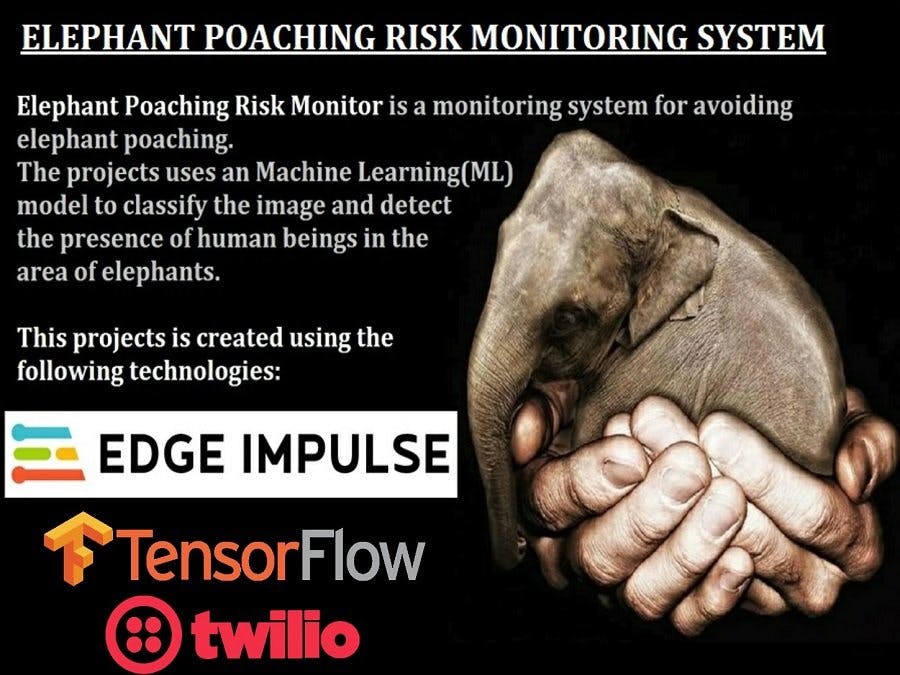There has been an upsurge in poaching and illegal ivory trafficking in recent years across the world. One of the main reasons for this increase is Insufficient anti-poaching capacity, weak law enforcement, lack of use of effective technologies, and corruption undermine efforts to stop poaching and trafficking in some countries.
My project is mainly made for preventing Elephant poaching by monitoring and detecting the presence of human beings in the areas where wild Elephants live and by alerting the wildlife rangers using an alert Multimedia Messaging Service(MMS) along with the detected details. The cameras and other sensors will always monitor the area where the wild Elephants are more found and detect the presence of humans by using effective Machine Learning(ML) models. The given below is the complete functioning flow diagram of this project.
Once if humans are detected in the areas near Elephants, an alert message with the captured image and location will be sent to the wildlife rangers' phone.
Screenshots of received alert Messages:
Detection of elephants and humans is done with the help of an efficient Machine Learning(ML) model. Machine Learning(ML) model is mainly programmed using the Python programming language and TensorFlow framework.
- Screenshots of Human and Elephant Detection Program's Output:
Edge Impulse Studio is used for creating an efficient ML model to classify and detect the presence of humans in the wildlife. Using the Edge Impulse Studio the model can be easily converted to a Lite model that can be also used on Android applications with the help of TensorFlow Lite. Also, it helps to interface and deploy model with any hardware components like Arduino, Xilinx, Raspberry, OpenMV, Web Assembly, and also on the web applications by converting it into supporting libraries. Version control and Deployment are very easy using Edge Impulse Studio.
The image classification model has been developed using Edge Impulse Studio. The various steps involved in the Edge Impulse Studio for building an efficient ML model includes:
- Devices Edge
- Data Acquisition
- Impulse Design
- Retrain Model
- Live Classification
- Model Testing
- Versioning
- Deployment
The given below are the stepwise screenshots of the Image Classification Machine Learning(ML) Model development done on the Edge Impulse Studio platform:
Devices Edge
You can connect any of your devices to your Machine Learning(ML) model wireless or also by wired using the Edge Impulse Studio. The process connection of devices is given below,
- Select the type of device which you like to connect to your model.
- If you are connecting smart devices then you can connect using a QR code.
Data Acquisition
This is the major area where we are going to provide the data for the creation of the ML model. The Train and Test data along with the label name are uploaded manually here.
Impulse Design
The below given is the screenshot of the Transfer Learning process inside the impulse design which is carried out with:
- Epoch Rate: 35 epochs
- Learning Rate: 0.005
- Minimum Confidence Rating: 0.80
Retraining Model
The Below given screenshot contains the retraining of the image classification model by using two known parameters:
- Image
- Transfer Learning
Live Classification
The given below is the live image classification process developed on Edge Impulse which gives an image classification with accuracy of 1.00 (i.e 100%)
Versioning
Using Edge Impulse Studios we can perform version control.
Deployment
We can deploy our impulse into any device, and we can make our project working on any devices even without an internet connection, minimizes latency, and runs with minimum power consumption.
For deploying our impulse into other devices first, we have to create a library. Using Edge Impulse Studios we can create a library easily by converting our impulse into optimized source code.
Impulse Creation Successful
Once your Impulse Creation is successful, the screen will be shown like below screenshot:
The output of the Human and Elephant Detection in an image using the object detection program. The classified image by Edge Impulse Studio ML model is used for Human detection to check the presence of Human beings.
Screenshot of Human and Elephant detection:
Here I have used an online platform called Twilio (twilio.com). Twilio allows software developers to programmatically make and receive phone calls, send and receive text messages, and perform other communication functions using its web service APIs for free for a limited amount of times. In most of the Surveillance cameras used for wildlife-security uses GPS either you can use the maps or geolocation APIs to share the location or we can know the captured image's location using the image's information.
The given below is the python program for sending MMS to the wildlife rangers using Twilio :
# import the Twilio client from the dependency we just installed
from twilio.rest import Client
# the following line needs your Twilio Account SID and Auth Token
client = Client("ACxxxxxxxxxxxxxx", "zzzzzzzzzzzzz")
# this is the URL to an image file we're going to send in the MMS
media = "https://Your_Media_image's_Link"
# change the "from_" number to your Twilio number and the "to" number
# to the phone number you signed up for Twilio with, or upgrade your
# account to send MMS to any phone number that MMS is available
client.api.account.messages.create(to="Your_Phone_Number",
from_="Your_Twilio_Number",
media_url=media
body="Human Presence detected",
"Location:"
"Latitude:"= media(maps.lat()).found()"
"Longitude:"=media(maps.long()).found()"
media_url=media)Message Screenshot:
According to WWF, even after the ban on international trade of ivory, in Africa and other countries, elephants are still being poached in large numbers. More than Thousands of elephants are being killed every year for their ivory tusks. The ivory is often carved into ornaments, jewelry, and plays an important role in the black market.
In this current world of Machine Learning(ML), Artificial Intelligence(AI), and other valuable technologies, everything is very easy to develop and deploy. So only most of the problems can be solved by using technologies. The prevention of elephant poaching is possible by using these technologies. My project is an example of using technology effectively for saving or protecting the gentle giants in their natural habitats.









Comments
Please log in or sign up to comment.